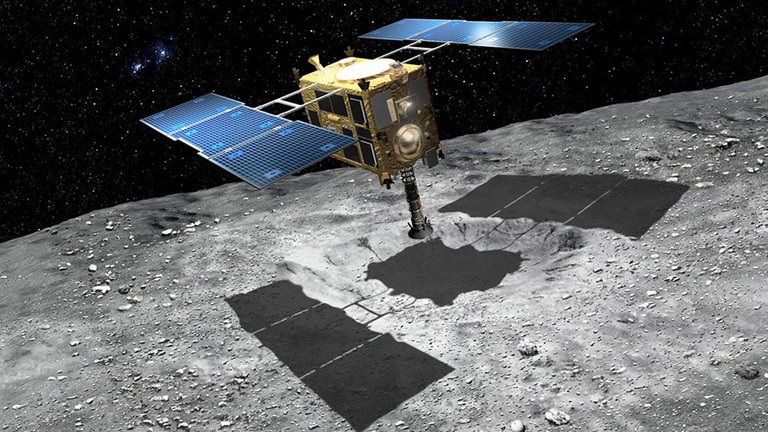Hurtling around the Sun along with the planets are millions of astetoids of various types and sizes. One of these is 162173 Ryugu, a near earth object that comes within 95400 km of earth at it's closest point. 1km in diameter, this primitive type of asteroid is expected to preserve pristine materials such as minerals, ice and possibly organic compounds. Studying samples from such an asteroid can help scientists better understand the origins of organic compounds and life on earth.

Hayabusa 2 approaches 162173 Ryugu (artist's impression)
Credit: Akihiro Ikeshita / JAXA
In 2014 the Hayabusa 2 spacecraft was launched from the Tanegashima space Centre in Japan, it's mission was to take measurements and collect samples from Ryugu and return them to Earth. Sharing it's ride up into orbit on a H-11A launch vehicle was the PROCYON asteroid flyby probe, intended to complete a separate mission. The PROCYON mission ultimately failed, however, the Hayabusa 2, using it's ion thrusters, successfully established a solar orbit alongside earth and Ryugu. Slowly spiralling out from it's position near earth it met up with Ryugu on its third solar orbit and synchronized itself in a steady position 20km away for initial mapping and investigations. On July 16 2018 in moved in to it's hovering altitude and began the serious work of launching rovers and collecting samples. The mission was coordinated via microwave electromagnetic radio signals between ground stations in Japan and Argentina as well the NASA Deep Space Network. This mission operated by the Japanese Aerospace Exploration Agency (JAXA) follows on the Hayabusa (peregrine falcon) sample return mission which was completed in 2010 with samples of 25143 Itokawa.
Among the Hayabusa 2's scientific payload was the MINERVA II-1 container containing two identically shaped cylindrical rovers. Due to the low gravity of the asteroid driving was not possible therefore these Japanese developed rovers were designed to hop into a new location in order to gather two sets of information. Both were successful in taking measurements pictures and even video from the asteroid surface.The MINERVA II-2 container held another Japanese rover which although it failed before launch was released into orbit around the asteroid to gather gravitational data. It was launched on 2 October and crashed unto the surface a few days later. A third rover launch deployed the MASCOT rover on October 3rd. This European developed rover was also able to tumble to another location and successfully collected two sets of measurements leading to new discoveries about C-type asteroids.

Asteroid surface photographed by Hayabusa 2 rover.
Credit: Twitter/JAXA
More important perhaps than the information gathered by the rovers was the mission to collect samples of regolith (loose material from the asteroid surface) and subsurface material. For this purpose Hayabusa 2 was equipped with various additional apparatus most notably a funnel shaped sample collection horn extending from below the spacecraft. The collection was initially postponed because investigations by the rovers indicated a hard rocky surface without regolith. A significant amount of material was however obtained by lowering the tube to the surface and blasting a specially designed bullet into the surface. The impact successfully dislodged a substantial amount of material that was then collected by the catcher at the top of the tube.
In order to get subsurface material unaffected by space weathering an SCI (small carry-on impactor) was necessary. Hayabusa 2 first deployed a specially designed camera, to catch the action before releasing the SCI and thrusting itself to the other side of the asteroid for protection. About 40mins later 2.5kgs of copper projectile was shot at the surface from about 500m by a plasticized HMX charge creating a crater about 10m diameter. The Hayabusa 2 hovered back around and after first releasing a navigational target marker, touched down once again to collect material through the collection horn. As a significant amount of material had already been collected and in order to reduce risk a second surface sample was ultimately cancelled. Samples were stored in separate sealed containers onboard a thermally insulated sample return capsule which will parachute down to earth to be collected in Australia.

Hayabusa 2 collects sample from Ryugu (artist's impression)
Credit: Akihiro Ikeshita / JAXA
After over a year orbiting the sun alongside Ryugu the Hayabusa 2 used it's ion thrusters, altering it's orbit with the asteroid and began it's return to Earth in November 2019. Due to the gravity of the Sun the return journey will be much quicker and is due to release the sample capsule to be collected in December 2020. Although the Hayabusa 2 will have traveled 5240 million kilometers most of the distance will be unpropelled as it orbits the sun. After releasing the sample capsule it will still have about half of it's xenon fuel available for a mission extension. So far a flyby mission of (98943) 2001 CC21 and a rendezvous with 1998 KY 26 are being considered as well as further observations of exoplanets.
Congratulations @edelweird! You have completed the following achievement on the Hive blockchain and have been rewarded with new badge(s) :
You can view your badges on your board and compare yourself to others in the Ranking
If you no longer want to receive notifications, reply to this comment with the word
STOPDo not miss the last post from @hivebuzz: